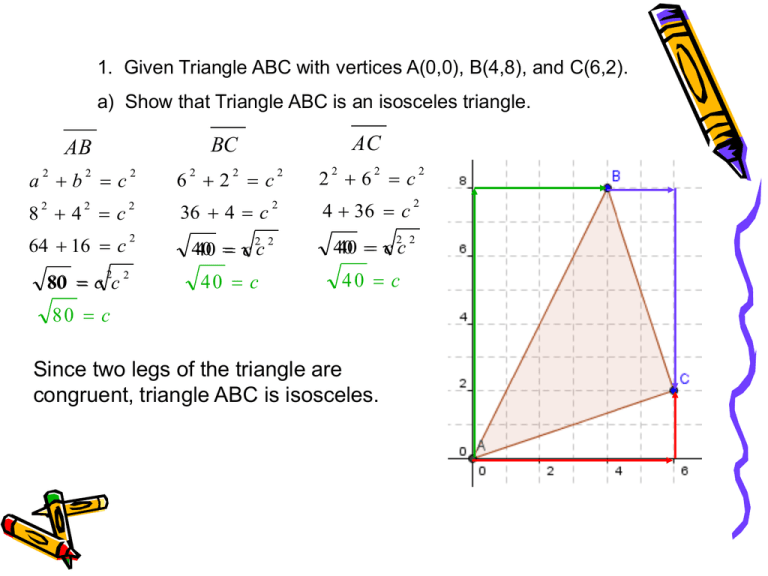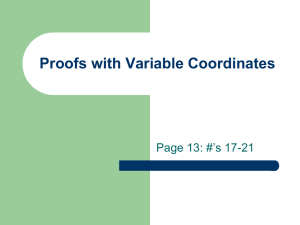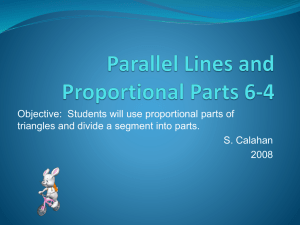Slide 1 - Camden Central School
advertisement

1. Given Triangle ABC with vertices A(0,0), B(4,8), and C(6,2). a) Show that Triangle ABC is an isosceles triangle. AC BC AB a b c 2 6 2 c 8 4 c 2 36 4 c 64 16 c 2 2 2 2 2 80 c c 2 2 2 2 2 2 2 6 c 2 2 4 36 c 40 40 c c 40 40 c c 40 c 40 c 2 2 2 2 2 80 c Since two legs of the triangle are congruent, triangle ABC is isosceles. 2 1. Given Triangle ABC with vertices A(0,0), B(4,8), and C(6,2). b) Find the coordinates of D, the midpoint of the base. Midpoint: (2,4) 1. Given Triangle ABC with vertices A(0,0), B(4,8), and C(6,2). c) Show that CD is perpendicular to AB. CD AB m rise run m 8 m 2 4 1 2 2 4 Since the slopes of AB and CD are negative reciprocals, AB is perpendicular to CD. D 6a. Given the verticies of PQRS with P(0,0), Q(4,3), R(7,-1), and S(3,-4) Show that PQRS is a rhombus. SP QR PQ a b c 2 3 4 c 3 4 c 2 9 16 c 2 2 2 2 9 16 c 25 c c 25 2 2 2 2 3 4 c 2 RS 2 2 2 3 4 c 2 2 9 16 c 25 c c 25 25 c c 25 5c 5c 2 2 2 2 2 9 16 c 25 c c 25 5c PQ QR RS SP Since all four sides of quadrilateral PQRS are congruent, PQRS is a rhombus. 2 2 2 2 2 5c 2 6b. Show that PQRS is a square. QR PQ m rise m 3 run m 4 4 3 3 4 RS m 3 4 m SP 4 3 4 3 Since each pair of consecutive sides of the rhombus have slopes that are negative reciprocals, they are all perpendicular and form four right angles. Since PQRS is a rhombus with all right angles, it is a square. Page 12 Homework 2a,3 2. Given Triangle RST with vertices R(0,6), S(2,0), and T(8,2). a.) Show that Triangle RST is a right triangle and state a reason for your conclusion. RS m ST rise run m 6 m 2 6 1 3 3 2 The slopes of two consecutive sides are negative reciprocals, which makes them perpendicular, forming a right angle. Therefore, triangle RST is a right triangle. 3. Given triangle PQR with vertices P(2,4), Q(5,8), and R(9,5). a.) Show that Triangle PQR is isosceles. b.) Show that Triangle PQR is a right triangle. QR PQ a b c 2 3 4 c 3 4 c 2 9 16 c 2 2 2 2 9 16 c 25 25 c c 2 2 2 2 2 2 2 25 25 c c 2 2 5c 5c PR 1 7 c 2 2 1 49 c 2 2 50 50 c c 2 50 c 2 PQ Q R Since two legs of the triangle are congruent, PQR is an isosceles triangle. 3. Given triangle PQR with vertices P(2,4), Q(5,8), and R(9,5). a.) Show that Triangle PQR is isosceles. b.) Show that Triangle PQR is a right triangle. PQ 5 ? 5 5 50 ? 25 25 50 2 QR 5 PR 50 2 2 50 50 Since the lengths of the sides of the triangles work in the pythagorean theorem, triangle PQR is a right triangle. 7a) The vertices of quadrilateral ABCD are A(1,1), B(3,4), C(9,1) and D(7,-2). Show that the quadrilateral is a parallelogram. BC AB m rise m 6 run m 3 1 2 3 2 DA CD m 3 m 2 3 6 Since the slopes of both pairs of opposite sides are equal, they are parallel. Quadrilateral ABCD, with both pairs of opposite sides parallel, is a parallelogram. 1 2 KN m Page 12 LM rise m 4 #8 2 2 run 4 m 2 2 Since the slopes of KN and LM are equal, KN is parallel to LM. KN LM a b c 2 4 2 c 4 2 c 2 16 4 c 2 2 2 2 16 4 c 20 c c 20 2 2 2 20 c 2 2 2 2 20 c c 2 2 20 c KN LM Since one pair of opposite sides of quadrilateral KLMN are both parallel and congruent, KLMN is a parallelogram. 13) Quadrilateral DEFG has vertices D(-4,0), E(0,1), F(4,-1) and G(-4,-3). A) show that DEFG is a trapezoid. EF DE rise m m 2 run 1 m 4 4 FG GD m 2 8 1 4 m 1 2 3 0 undefined The slopes of DE and FG are equal, so DE is parallel to FG. The slopes of EF and GD are not equal, so EF is not parallel to GD. Therefore quadrilateral DEFG with only one pair of opposite sides parallel is a trapezoid. 13) Quadrilateral DEFG has vertices D(-4,0), E(0,1), F(4,-1) and G(-4,-3). B) Show that DEFG is not an isosceles trapezoid. DG EF 3 a b c 2 2 2 2 4 c 2 4 16 c 2 2 2 2 20 20 c c 20 c Since the lengths of the nonparallel sides are not equal, DEFG is not an isosceles trapezoid. 2 13) Quadrilateral DEFG has vertices D(-4,0), E(0,1), F(4,-1) and G(-4,-3). C) Show that diagonals DF and EG do not bisect each other. DF xm xm xm x1 x 2 2 44 2 0 2 0 ym ym y1 y 2 2 0 1 ym 1 M 0, 2 2 1 2 EG xm xm 40 2 4 2 2 ym ym 1 3 2 2 1 2 M 2 , 1 Since the midpoints of the two diagonals are not the same point, diagonals DF and EG do not bisect each other. 9. Quadrilateral ABCD has vertices A(4,4), B(2,0), C(-4,-2) and D(-2,2). Show that ABCD is a parallelogram. BC AB m rise m 2 run 4 m 2 2 6 CD DA m 4 2 2 m 2 6 1 3 1 3 Since the slopes of both pairs of opposite sides are equal, the opposite sides are parallel. Therefore quadrilateral ABCD, with both pairs of opposite sides parallel, is a parallelogram. Page 12-13 Homework 14,15a 14) A(1,3), B(-1,1), C(-1,-2) and D(4,3) are the vertices of quadrilateral ABCD. Show that ABCD is an isosceles trapezoid. SLOPE AB rise m run 2 m 1 2 BC m DA CD 3 0 m 5 1 m 5 undefined Since the slopes of AB and CD are equal, AB is parallel to CD. The slopes of BC and DA are not equal, so BC is not parallel to DA. Quadrilateral ABCD with only one pair of parallel sides is a trapezoid. 0 3 14) A(1,3), B(-1,1), C(-1,-2) and D(4,3) are the vertices of quadrilateral ABCD. Show that ABCD is an isosceles trapezoid. Distance BC 3 AD 3 BC AD Since the lengths of the nonparallel sides of trapezoid ABCD are congruent, ABCD is an isosceles trapezoid. 15. The vertices of triangle ABC are A(0,10), B(5,0), and C(8,4) a.) Show that triangle ABC is a right triangle. AC m BC rise m 3 run m 6 8 4 3 4 The slopes of two consecutive sides are negative reciprocals, which makes them perpendicular, forming a right angle. Therefore, triangle ABC is a right triangle. 15. The vertices of triangle ABC are A(0,10), B(5,0), and C(8,4) b.) Point D(4,2) lies on AB. Show that CD is the altitude to AB. CD AB m rise run m 10 m 2 4 1 2 2 5 The slopes of AB and CD are negative reciprocals, which makes AB perpendicular to CD. Since CD extends from a vertex perpendicular D to the base, it is the altitude to AB. 10. Quadrilateral PQRS has vertices P(0,2), Q(4,8), R(7,6) and S(3,0). Show that ABCD is a rectangle. PQ m QR rise m 3 run 6 3 m 4 2 RS m 6 4 2 SP 3 2 m 2 3 The slopes of all of the consecutive sides are negative reciprocals, therefore they are perpendicular, forming right angles. Therefore, quadrilateral PQRS with 4 right angles is a rectangle. 16. A(0,2), B(9,14), and C(12,2) are the vertices of triangle ABC. D(6,10) is a point on AB and E(8,2) is a point on AC. a.) Show that DE is parallel to BC. BC DE m rise run m 8 m 12 4 3 4 2 Since the slopes of DE and BC are equal, DE is parallel to BC. 12. Draw any quadrilateral. Find the midpoints of each side of your quadrilateral. Show that the quadrilateral formed from connecting the midpoints is always a parallelogram. HOMEWORK •Page 12-13 #10, 12, 16a









